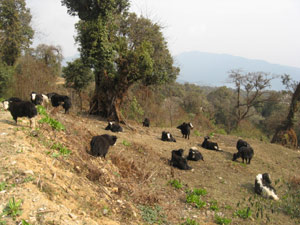New Act on Forest land use aims at protecting the interests of poor livestock rearers
Jun 18, 2009
The new Land Act of 2007 of Bhutan, states that all private and community owned tsamdro land (forest land used for grazing) and sokshing land (forest land used for leaf litter collection) will now be returned back to the government.
These lands also termed as CPRs were earlier used as grazing lands on the payment of a nominal annual fee to the Government. The law envisages allocation of the land (forest land for grazing) to those having livestock while the other land area under leaf biomass collection, will be allocated for fodder cultivation. The heavy degradation of the lands is the main reason behind this decision.
Implementation of this new act will take into consideration critical issues such as compensation process and formulate rules and regulations to address issues like the Government taking over the land (used for grazing) from registered families. There is no compensation for taking over the land used for leaf litter collection. (Adapted from Kuensel March 28, 2009)
In Bhutan forest resources are in abundance and easily accessible. While the subsistence agriculture is often not sufficient to satisfy food security of the community, the common resources are frequently exploited leading to degradation. The government is making efforts to protect grazing lands while also keeping the interest of the community in perspective as a whole.
In the earlier ”Land Act 1979”, owners had the land registered in their names, but with rights only to graze their cattle on tsamdro (forest land used for grazing) and sokshing (forest land used for leaf litter collection) to collect leaves for compost making. This was a prudent thinking based on the past experience of land use which had land registered under individual names but was not used for grazing (the families had no livestock) and agricultural purposes. Additionally as per land act 1979, there is no legal basis for permitting lease of government land for pasture development while this has been incorporated in the land act of 2007. The leasing of government land has already been implemented on a pilot basis in few Dzongkhags (districts).
In addition, the community also has access to private land devoted to fodder cultivation. Depending on the captive need for food, the individual farmer can reallocate land either for crop production or can have mixed cropping with forage and food crops.
CPR management at high altitudes
 CPR management in the rangeland at higher altitudes has been introduced recently and works on the principle of shifting cultivation and rotational grazing. The stakeholders are livestock owners including yak rearers. The families with or without cattle and land are also included to form a formal committee to monitor grazing and maintain grass cover.
CPR management in the rangeland at higher altitudes has been introduced recently and works on the principle of shifting cultivation and rotational grazing. The stakeholders are livestock owners including yak rearers. The families with or without cattle and land are also included to form a formal committee to monitor grazing and maintain grass cover.
The land is allowed for free grazing to village cattle and there is no enclosure or boundary. However, to make best use of the natural grass available, grazing is practiced in rotation. In order to ensure regeneration of the native grasses, grazing is banned for two months in a year. Owing to the novelty of the intervention for the community, their participation has gradually been ensured. The benefits are in the form of increase in the overall cattle population and especially the yak population.
The country has 72% land area under forest cover, moreover the terrain and the geo-physical topography makes the land inaccessible. Keeping all these factors in view, including the interest of the livestock owners in fodder for their animals and to avoid further degradation of land and forest resources, the Government is making all efforts to formulate location specific and need based policies to balance the situation.
Contributed by - Ministry of Agriculture and Forests, Bhutan and BAIF, India









